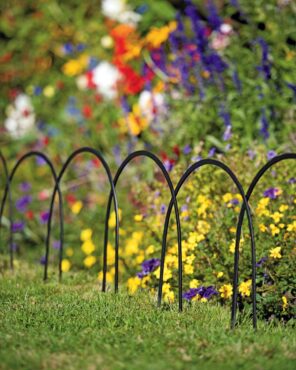
Create a front garden that is sure to boost your mood and welcome visitors all year round. All you need is one weekend and a bit of paint, flowers, décor and edging material to boost your landscape’s curb appeal.
The Front Door
Add a splash of color by painting your front door. Look for colors that complement your home’s siding and the surrounding landscape. Then add a seasonal wreath or other door decoration.
A wreath of seed packets in the spring, succulents or silk flowers in summer, dried materials in fall and greens in winter add seasonal interest to your home. Visitors will look forward to the change of seasons marked by your door’s décor.
The Front Entrance
Add a few containers at the front entrance. Select a color and size that complements your home’s size and architecture style.
Reduce maintenance with self-watering containers that extend the time between watering. Further your enjoyment with solar-illuminated planters powered by the sun to add a magical glow to the landscape as the sun sets.
Planting Beds
Define planting beds and create a finished look with edging. Use a sharp shovel to dig a V-shaped trench around small garden beds or employ the help of an edging machine for larger areas. Fill the trench with mulch to create a mowing edge and keep weeds out.
Or boost the aesthetic appeal and further define the space with edging materials like the Stomp Edge. This easy-to-install edging material is made from recycled rubber and only requires a few hand tools and minimal time to install.
Keep unruly plants out of the lawn or off walkways while defining the garden space with decorative garden edging. You can keep it simple with Gardener’s Supply Company’s Stratford Edge Irons that mimic the edging found in Shakespeare’s garden in Stratford England. Or add an artistic flare with a more decorative edging like the Nocturne Border Edging.
Weeding
Weed garden beds to improve the overall appearance and health of garden plants. Weeds not only compete with your desirable plants for water and nutrients, but many are hosts for insect pests and diseases that can harm your desirable plants.
Mulching
Once weeded, spread a 1- to 3-inch layer of organic mulch like shredded leaves, evergreen needles or woodchips over the soil surface. The finer the material, the thinner the layer of mulch needed.
Organic mulch helps conserve moisture, suppress weeds and improve the soil as it breaks down. Select a mulch that is aesthetically pleasing and won’t overwhelm the beauty of the plants.
Keep mulch off tree trunks, shrubs, stems and crowns of perennial and annual plants. Covering stems and plant crowns can lead to root rot and other problems that can negatively impact the plants’ health and longevity.
Freshen existing wood mulch by lightly tilling or raking, so the darker mulch below the surface moves to the top. Avoid overmulching. It is a waste of money and can be harmful to your plants.
Make it a fun weekend by mixing in some tasty treats or a barbeque once the work is done. As you enjoy the benefits of your weekend’s efforts, you’ll be anxious to start tackling those bigger landscape tasks.
























